Early Evening Planets, the Waning Moon Tackles Taurus, and Cygnus Soars Above!


Hello, Late Summer Stargazers!
Here are your Astronomy Skylights for the week of September 15th, 2019 by Chris Vaughan. Feel free to pass this along to your friends and send me your comments, questions, and suggested topics. I repost these emails with photos at http://astrogeo.ca/skylights/ where all the old editions will be archived. You can also follow me on Twitter as @astrogeoguy! Unless otherwise noted, all times are Eastern Time. Please click this MailChimp link to subscribe to these emails.
I can bring my Digital Starlab portable inflatable planetarium to your school or other daytime or evening event. Contact me through AstroGeo.ca, and we’ll tour the Universe together!
For those who like to read my Skylights on Tumblr, I am now migrating the content to my website, where I can better control the size of the photos and sky charts. The page where the Skylights are listed is located at http://astrogeo.ca/skylights/. We’re still ironing out the site, so let me know if you have any comments or suggestions.
The Moon and Planets
This week, the moon will rise very late and wane in phase to last quarter, leaving evening skies the world over darker and darker. And with the September equinox right around the corner, sunsets in the Northern Hemisphere are arriving almost three minutes earlier every night – and that helps Jupiter remain nicely in view while it slides west and sunward. Keep your binoculars and telescopes handy – here are your Skylights!
As I just stated, the full Harvest Moon of Friday-Saturday will now wane in illuminated phase this week, and rise later – because it is in the third week of its monthly cycle. To start the week, the still-very-bright moon will rise at around 9 pm local time among the dim stars of Pisces (the Fishes). On Tuesday night, the moon will skim the head of Cetus (the Whale) and sit about a palm’s width below the planet Uranus. Note what part of the sky Uranus and the moon are in – because Uranus will remain there after the bright moon leaves the scene (more on this below).
On Thursday the moon will rise at about 10:30 pm among the brighter stars of Taurus (the Bull). Look for the tight little Pleiades Star Cluster sitting less than a fist’s width above the moon. Some people mistake this object for the Little Dipper. It is little, and it is somewhat dipper-shaped, but the genuine article is half the sky away – off to the Pleiades’ upper left.
During the rest of Thursday night, and all the way to dawn on Wednesday, the moon will approach and then enter the big triangular-shaped set of stars that compose the face of Taurus. Taurus’ face is actually a family of stars formed from the same molecular hydrogen cloud. Astronomers call these stars the Hyades open star cluster. Unlike most star clusters, the Hyades’ stars are widely separated in the sky (about three finger widths across) because they are located only about 150 light-years from our sun – almost neighbours! The moon’s orbital motion will be carrying it past Aldebaran, the very bright, orange-tinted star that marks the bull’s southern eye. Aldebaran is not part of the Hyades. It’s a different colour, and is much closer (66 light-years) than those stars. Observers who live in the Pacific Ocean region and Asia can watch the moon tackle Taurus in a dark sky.
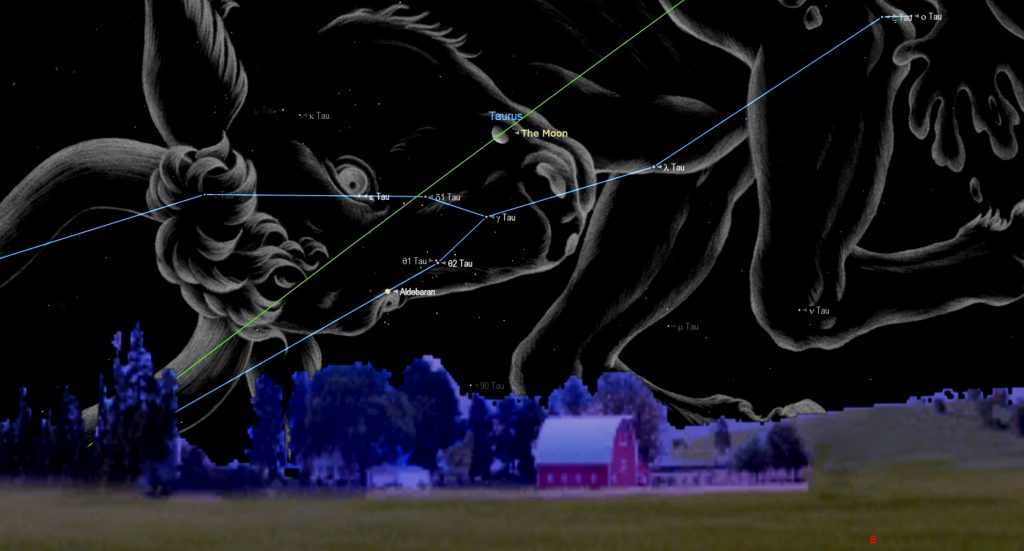
On Thursday evening, the moon will reach its last quarter phase. At its last quarter phase, the moon rises around midnight and remains visible in the southern sky all morning. At this phase, the moon is illuminated on its western side, towards the pre-dawn sun. Last quarter moons are positioned ahead of the Earth in our trip around the sun. Just as the moon looks most spectacular around first quarter, the last quarter moon is illuminated the same way, but with the sun is on the opposite side – and you need to stay up way past most people’s bedtime to see it! After this phase, the waning moon will traverse the last quarter of its orbit around the earth, on the way to new moon.
The moon will end the week as a thick, waning crescent tickling the toes of Gemini (the Twins) in the predawn sky.
Here’s what the planets are up to this week. Mars is now pulling away from the sun’s glare and will become visible in the eastern pre-dawn sky later this month. Unfortunately, the red planet is on the far side of the sun from us and will remain small and faint until 2020 begins.
Meanwhile, Mercury and Venus are also sitting quite close to the sun. Both of those planets are in the process of swinging away from the glare of sunset. In fact, swift Mercury did a “drive-by” kissing of Venus last Friday and will now be increasing its distance from that brighter planet every night. This week, you might be able to see Mercury and Venus sitting very low in the west for about 20 minutes after the sun disappears. By next Sunday, Mercury will be positioned about four finger widths to the left (celestial east) of Venus. The very shallow angle that the evening ecliptic makes with the western horizon will prevent people in the Northern Hemisphere from seeing them very easily at this time. But observers near the equator and in the Southern Hemisphere will see them well in the next couple of weeks.
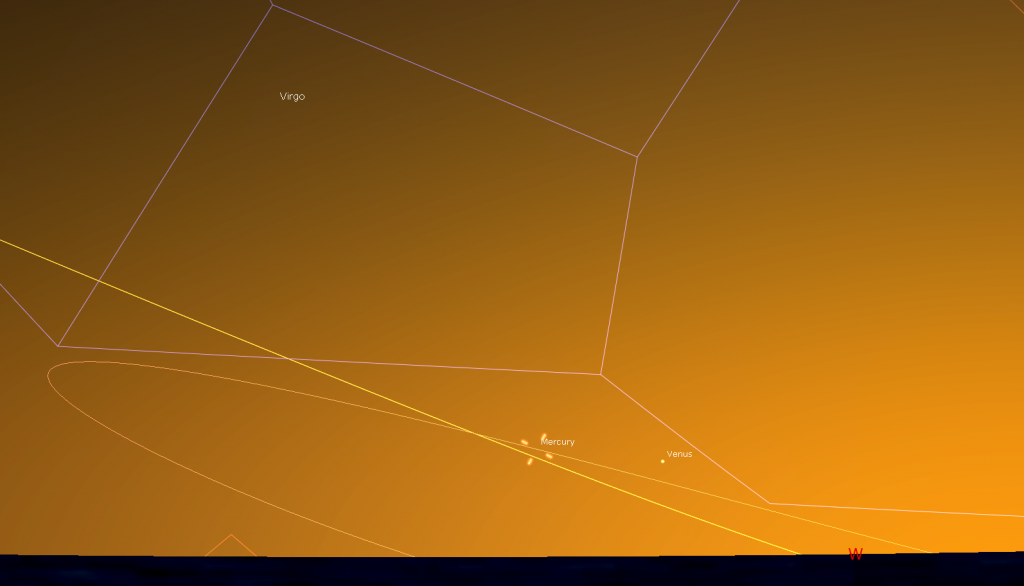
Ordinarily, because of the skyglow surrounding the setting sun, planets become harder to observe once they enter the southwestern evening sky on their way towards solar conjunction. But the earlier-arriving sunsets of September are allowing us to view spectacularly bright Jupiter for a while yet.
As the sky begins to darken this week, look for the giant planet Jupiter sitting less than a third of the way up the southwestern sky. Hour by hour, Jupiter will sink lower – then set in the west by about 11 pm local time. Jupiter has been spending this year below Ophiuchus (the Serpent-Bearer) and above Scorpius (the Scorpion). Antares, the very bright star that is sitting less than a fist’s diameter to the lower right (or celestial southwest) of Jupiter, marks the heart of the scorpion. You might notice the reddish tint gives Antares its name, which is Latin for “the rival of Mars”. The star’s position so low in the sky has been causing it to twinkle furiously because we are seeing it through a much thicker layer of intervening, turbulent air.
On a typical night, even a backyard telescope will show you Jupiter’s two main equatorial stripes and its four Galilean moons – Io, Europa, Callisto, and Ganymede looking like small white dots arranged in a rough line flanking the planet. Good binoculars will show the moons, too! If you see fewer than four dots, then the others are in front of Jupiter, or hidden behind it. Or, it might be that some moons are not being illuminated by sunlight because they are in eclipse!
If you watch Jupiter on Monday evening, September 16 before 8 pm, you will see only three moons – Io on the east side and Europa and Callisto on the west side. But a few minutes after 8 pm Eastern Daylight Time, the moon Ganymede will suddenly appear between Jupiter and Io as it exits Jupiter’s shadow and becomes bathed in sunlight! If your telescope has motors to track Jupiter, attach a smartphone holder and record a video of the moon appearing.
From time to time, the small, round, black shadows cast onto Jupiter’s surface by those four Galilean moons become visible in amateur telescopes as they cross (or transit) Jupiter’s disk. On Wednesday night from 8:45 to 11 pm EDT, observers in the Americas can watch Europa’s small shadow transit Jupiter. On Friday night from dusk to 9:50 pm EDT, observers in the Americas can watch Io’s shadow transit Jupiter.
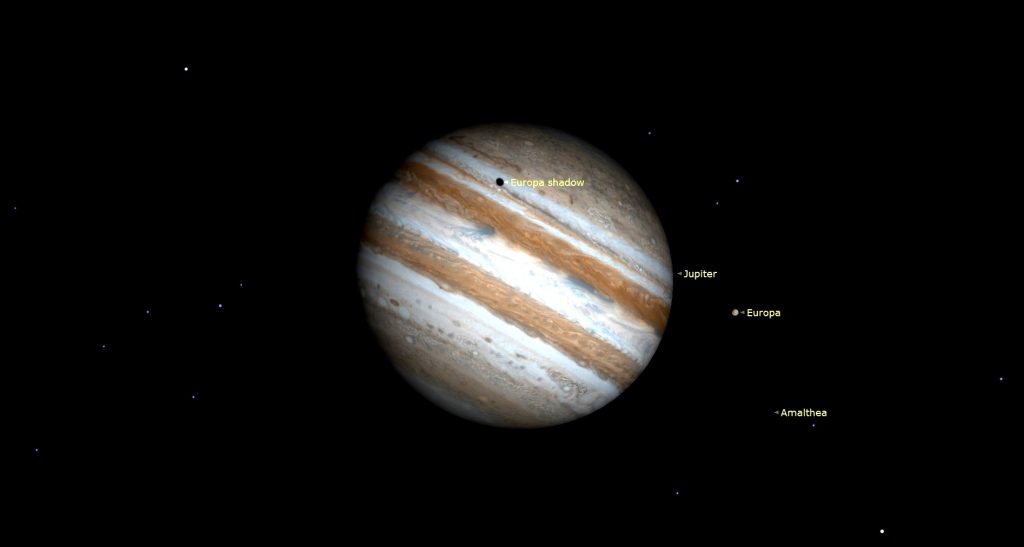
8:45 and 11 pm EDT. The event, visible in the western hemisphere is shown here at 9:15 pm EDT.
Due to Jupiter’s rapid 10-hour rotation period, the Great Red Spot (or GRS) is only observable from Earth every 2nd or 3rd night, and only during a predictable three-hour window. The GRS will be easiest to see using a medium-sized, or larger, aperture telescope on an evening of good seeing (steady air). If you’d like to see the Great Red Spot in your telescope, it will be crossing the planet on Monday evening after 9 pm EDT, on Thursday from dusk to 10 pm EDT, and on Saturday after 8:15 pm EDT.
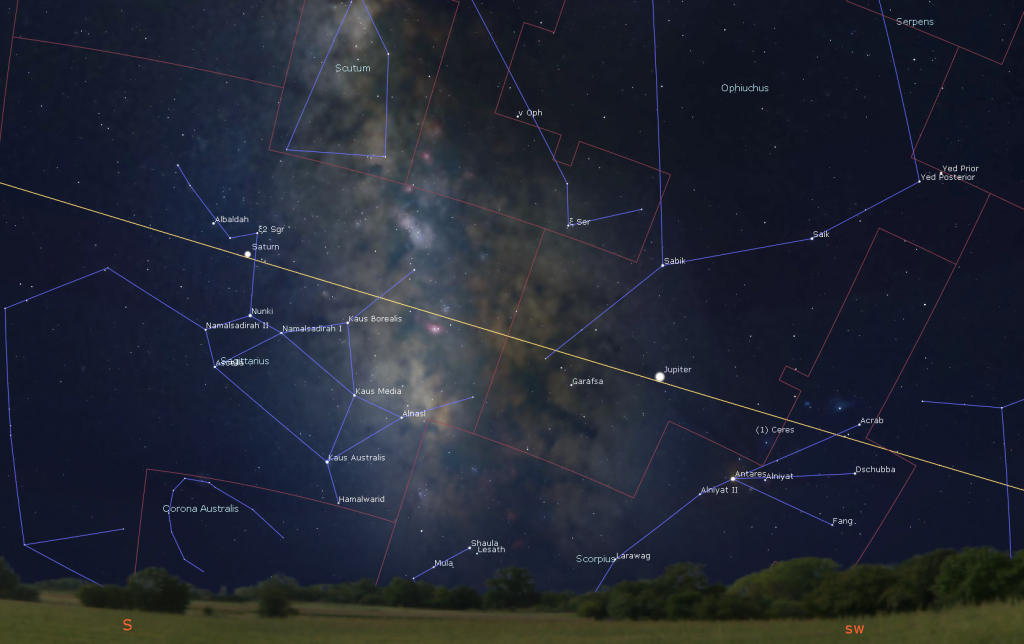
Yellow-tinted Saturn is prominent in the southern evening sky, too – but it is much less bright than Jupiter. The ringed planet will be visible from dusk until about 1 am local time. Saturn’s position in the sky is just to the upper left (or celestial east) of the stars that form the teapot-shaped constellation of Sagittarius (the Archer). To find Saturn, look about 3 fist diameters to the left (celestial east) of Jupiter. The Milky Way is between them.
Saturn is well worth dusting off your old telescope! Once the sky is dark, even a small telescope will show Saturn’s rings and several of its brighter moons, especially Titan! Because Saturn’s axis of rotation is tipped about 27° from vertical (a bit more than Earth’s axis), we can see the top surface of its rings, and its moons can arrange themselves above, below, or to either side of the planet. During this week, Titan will migrate counter-clockwise around Saturn, moving from the upper right of Saturn tonight (Sunday) to the left of the planet next Sunday. (Remember that your telescope will flip the view around.)
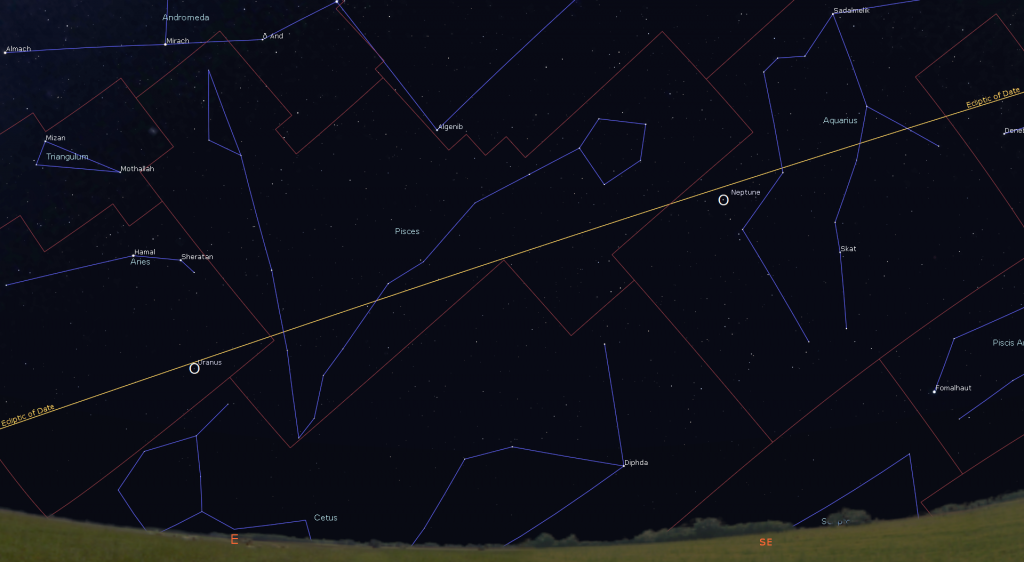
Last Tuesday, Earth’s orbital motion carried us between tiny, blue Neptune and the sun, causing Neptune to be closest to Earth for the year. The dim, magnitude 7.8, blue planet is visible all night long among the stars of eastern Aquarius, just a small distance to the right (celestial west) of a medium-bright star named Phi (φ) Aquarii. Both blue Neptune and that golden-tinted star will appear together in the field of view of a backyard telescope at medium power. The distance between the star and the planet will steadily increase due to Neptune’s westward retrograde orbital motion. I posted a diagram of Neptune’s position compared to that star here.
Blue-green Uranus will be rising in the east just before 9 pm local time this week; and it will remain visible all night long. Uranus is sitting below (or to the celestial south of) the stars of Aries (the Ram) and is just a palm’s width above the head of Cetus (the Whale). At magnitude 5.8, Uranus is actually bright enough to see in binoculars and small telescopes, under dark skies. You can use the three modest stars that form the top of the head of the whale (or sea-monster in some tales) to locate Uranus this autumn – that’s because the distant planet moves so slowly in its orbit. To help you find it, I posted a detailed star chart here.
If you’ve ever wanted to see an asteroid, Ceres, the first one discovered, is conveniently placed in the evening sky this month. Ceres’ name is related to the word “cereal”, as both arise from the Greek Goddess of Agriculture. Originally considered the missing planet between Mars and Jupiter after its discovery by Giuseppe Piazzi in 1801, Ceres was downgraded to an asteroid soon afterwards, and then upgraded to dwarf planet status in 2006 – at the same time Pluto was demoted to join the same family as Ceres.
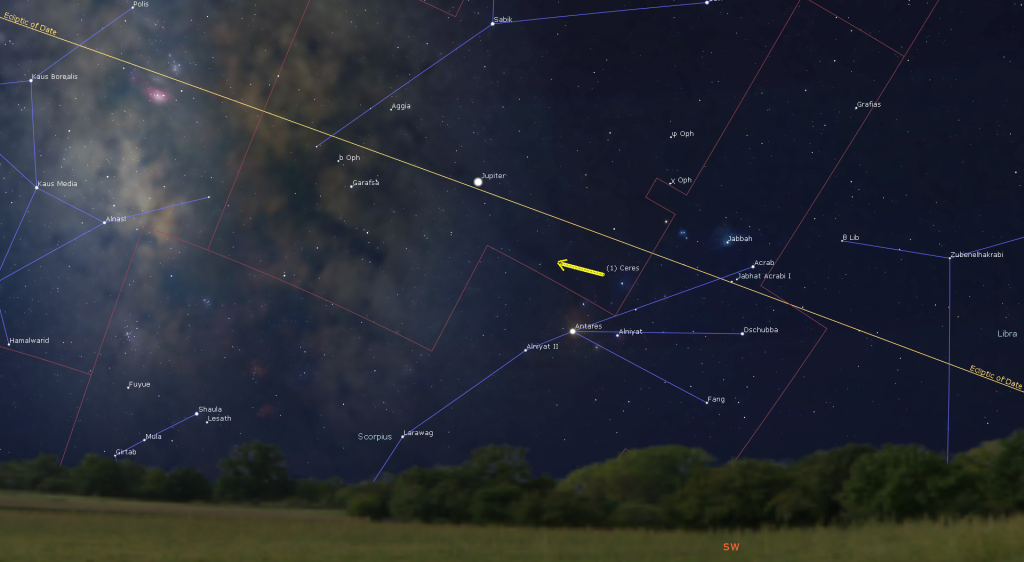
This week, Ceres will be slowly moving eastward above the bright, reddish star Antares in Scorpius. With a visual magnitude of 8.9, Ceres will be readily seen in backyard telescopes. Binoculars will work, too – once the bright moon leaves the scene. Ceres is located about three degrees (3 finger widths) to the upper right (or celestial north) of Antares.
September Stargazing Round-up – Cygnus
With darkness falling earlier and mild evening temperatures, now’s a good time get out under the stars. Objects in the sky directly overhead will always appear at their best because you are looking through the least amount of intervening air. In early evening during mid-September every year, the constellations of Lyra (the Harp), Cygnus (the Swan), Hercules, and Draco (the Dragon) surround the zenith. A few weeks ago we toured Lyra here, pointing out some objects you can look at with binoculars and small telescopes. Up next is Cygnus!
Head outside on the next clear evening, face east, and look nearly overhead for the very bright star Vega. Below it is the realm of the great constellation Cygnus (the Swan). These stars double as the asterism called the Northern Cross. In size, Cygnus is the 16th largest of the 88 official constellations. It sits entirely north of the celestial equator and some of its more northerly stars are circumpolar – that is, they never set for observers in mid-northern latitudes around the world.
This constellation is one of the few that truly resembles the name. Cygnus occurs in Greek mythology as Zeus, who used the form of a beautiful swan to seduce Leda, the mother of Helen of Troy. It is also said to represent mourning Orpheus – his harp situated nearby in Lyra. The Arabs saw a hen, the Dakota people of North America saw a salamander, the Ojibwa people saw a crane. The Mongolians saw a bow and arrow, while the Chinese used a different grouping of stars and formed a river crossing.
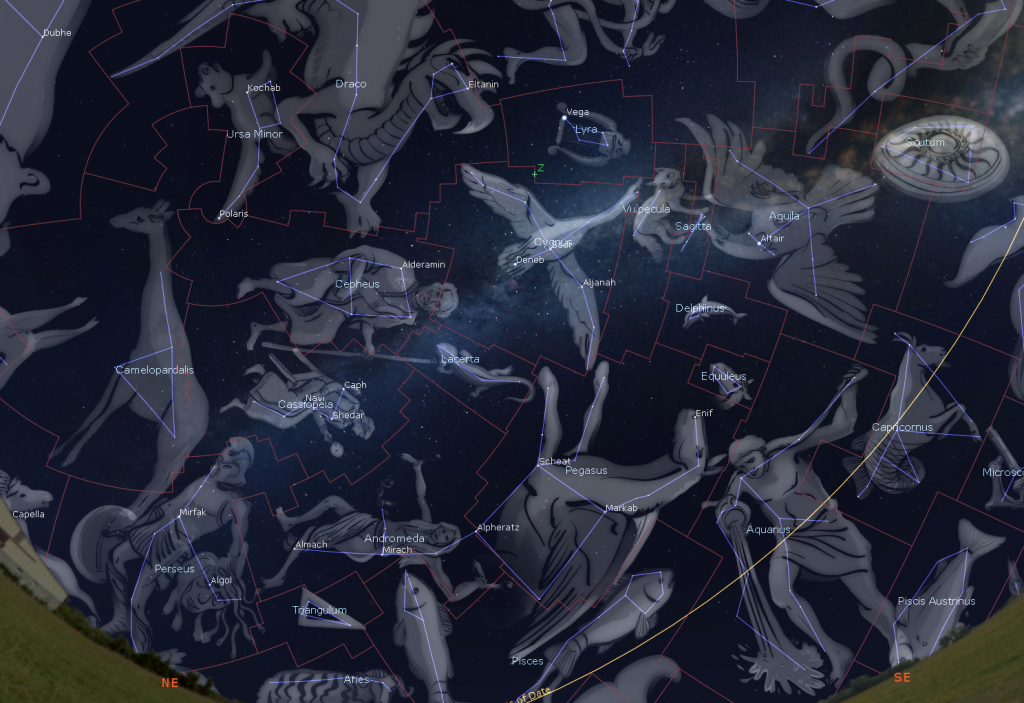
From Vega, move 23° or 2.3 fist diameters (held at arm’s length) to the lower left (or to celestial east). The bright blue-white star Deneb marks the tail of the swan, and actually means “tail” in Arabic. Deneb is a very distant (~1,550 light-years away) luminous supergiant star that shines many tens of thousands of times brighter than our Sun. The slow wobble of the Earth’s axis will cause Deneb to become the North Pole Star around AD 9,800, as it was before, in 16,000 BC.
About a palm’s width to the right (or southwest) of Deneb is another prominent star which marks the centre of the swan’s body. It is called Sadr, Arabic for “the hen’s breast”. Sadr is about as far away as Deneb, and is also extra luminous, but cooler than Deneb, giving it a warmer colour.
The swan’s head, a modest star named Albireo sits approximately 16° (1.6 fist widths) to the right of Sadr – swans have long necks! It sits in the centre of the Summer Triangle. Albireo is a favorite of summer star parties because it is a coloured double star easily seen in a small telescope. The two stars are a lovely sapphire and topaz in colour – because they are burning at 11,000 degrees and 4,400 degrees respectively. They sit about 380 light years away and are likely a line-of-sight double – a happenstance of geometry. Albireo was given its single name before telescopes were invented and revealed that it was actually a duo.
With Deneb, Sadr, and Albireo forming an imaginary left-right line, you should now be able to locate a long upright chain of spaced-out stars forming the swan’s broad wings. Each wing extends about two fist diameters above and below Sadr and contains three stars.
Let’s tour the wings. Moving upwards (or celestial north) from Sadr, we first arrive at Al Fawaris (“the Riders”) also known as Delta Cygni. It sits about 8° (less than a fist’s width) away from Sadr. It has also been called Rukh, after the giant bird The Roc in Middle Eastern mythology (and some sword and sandal movies). Decent telescopes should be able to split that star into a pair of greenish-blue and yellow-white stars. This star will also one day become Earth’s pole star. A further jump of 7° to the upper left lands us at white Iota Cygni. And a couple of finger widths beyond that is the wingtip star, yellowish Kappa Cygni.
Next, moving about 8° downwards from Sadr we find the bright, yellow-orange star Gienah (aka Epsilon Cygni), a name derived from the Arabic words for “Wing of the Swan”. Gienah is an old star at the beginning of its death process. Looking slightly to the left and a palm’s width below Gienah is the yellow-orange star Zeta Cygni. Finally, a little more bending to the left and another palm’s width lower is the tightly separated double star Mu Cygni. This pair of stars is orbiting one another with a period of about 790 years. And because their orbit is nearly edge on to us, they slowly move closer together and draw farther apart over the decades. Right now they are separating.
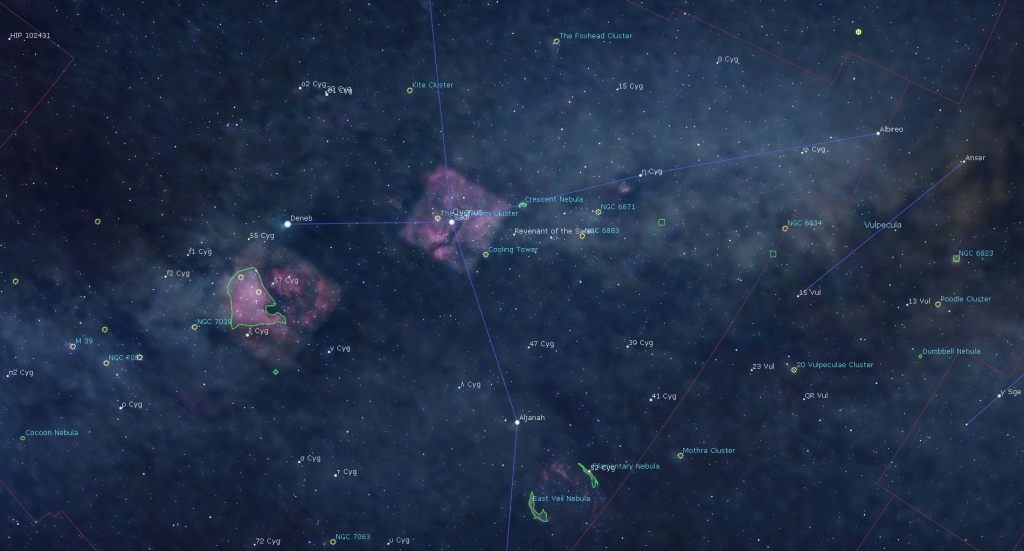
If you can leave the light polluted skies of the city, look for some of Cygnus’ wonderful nebulae. Nebulae are clouds of gas and dust that glow in a variety of colours – lit from within by the radiation emitted from the stars they contain. A few finger widths below Deneb is the North American Nebula, named for its distinctive shape. Around Sadr lies the Gamma Cygni Nebula, a cloud that is actually six full Moon widths across! Sadr is not connected to the nebula, though – at 1800 light-years distant, it’s only half as far away as the nebula!
About three finger widths to the lower right of Gienah is the large, delicate, and pink Veil Nebula or Cygnus Loop. Its roughly circular shape, five full Moon diameters across, is the tattered remnant shell of a supernova that occurred some five to eight thousand years ago. These large objects are best seen with binoculars, and sometimes unaided eyes, under very dark, moonless skies – check them out!
If you are in a dark location and the Moon isn’t too bright, you can see that the band of the Milky Way runs directly through Cygnus, as if she is about to land for a swim! The rich star fields surrounding the constellation are terrific for laying back and scanning with binoculars. You might find one of the many open star clusters in Cygnus, such as the Cooling Tower Cluster (Messier 29), which is located less than two finger widths to the lower right of Sadr, and the Foxhead Cluster, which is a generous palm’s width above Sadr.
Telescope owners should look for the Blinking Planetary. It’s a stellar corpse (like Lyra’s Ring Nebula) that plays an optical illusion on you. When you look straight at it, its central white dwarf shines as a tiny pinprick. But use averted vision, and the blue halo pops into view. You can make the two views flip back and forth. It’s fun! The object is located about two finger widths to the lower left of the line joining Al Fawaris and Iota Cygni (in the upper wing), and it’s closer to Iota Cygni.
Let me know how your exploration of Cygnus goes.
Public Astro-Themed Events
Every Monday evening, York University’s Allan I. Carswell Observatory runs an online star party – broadcasting views from four telescopes/cameras, answering viewer questions, and taking requests! Details are here. On Wednesday nights they offer free public viewing through their rooftop telescopes. If it’s cloudy, the astronomers give tours and presentations. Details are here.
Science Literacy Week has arrived in the GTA! A number of library branches in Toronto will be hosting free, public, astronomy-themed presentations this week. Here’s a list:
On Monday, September 16 from 3:30 pm to 7:00 pm at Gerrard/Ashdale Library, Astronomy: A Fascinating Tour of the Universe, by Tom Vassos. Details are here.
On Tuesday, September 17 from 2 to 3 pm at Deer Park Library, Toronto’s Astronomical Heritage, by Professor Emeritus John Percy. Details are here.
On Tuesday, September 17 from 3:30 to 4:30 pm at Maria A. Shchuka Library, Gravitational Waves: Sirens of the Universe, by PhD Candidate CJ Woodford. Details are here.
On Tuesday, September 17 from 6:30 to 8 pm at Lilian H. Smith Library, Our Manifest Galaxy: A Performance About Space Exploration, by artist Pamela Neil, indigenous expert Melanie Goodchild, and astrophysicist Renée Hložek. Details are here.
On Thursday, September 19 from 6:30 to 7:30 pm at Cliffcrest Library, Common Misconceptions of the Universe, by Professor Emeritus John Percy. Details are here.
On Thursday, September 19 from 6:30 to 8 pm at Barbara Frum Library, The Dish, the Desert and the Dawn of the Universe, by Professor Brian Gaensler. Details are here.
On Saturday, September 21 from 2 to 3:30 pm at Forest Hill Library, Meet an Astronomer: A Fascinating Tour of the Universe, with Tom Vassos. Details are here.
Local universities will also host public science-themed events this week, including York University (listed here), McMaster University (listed here), Ryerson University (listed here), and University of Toronto (listed here).
If it’s sunny on Saturday morning, September 21 from 10 am to noon, astronomers from the RASC Toronto Centre will be setting up outside the main doors of the Ontario Science Centre for Solar Observing. Come and see the Sun in detail through special equipment designed to view it safely. This is a free event (details here), but parking and admission fees inside the Science Centre will still apply. Check the RASC Toronto Centre website or their Facebook page for the Go or No-Go notification.
On Saturday, September 21 from 1 to 4 pm at Mississauga Central Library, RCI Science and Indus Space will present a free, public event called Space: Oceans: Beyond Earth. Details are here.
On Sunday, September 22 from 7 to 9 pm at the Ontario Place South Marina, join Elder Duke Redbird and astrophysicist Dr. Renée Hložek for an intimate conversation under the stars to discuss the human relationship to the cosmos from a multiplicity of perspectives. Details are here.
The next RASC-hosted Night at the David Dunlap Observatory will be on Saturday, September 21. There will be sky tours in the Skylab planetarium room, space crafts, a tour of the giant 74” telescope, and viewing through the 74” and lawn telescopes (weather permitting). The doors will open at 8:30 pm for a 9 pm start. Attendance is by tickets only, available here. If you are a RASC Toronto Centre member and wish to help us at DDO in the future, please fill out the volunteer form here. And to join RASC Toronto Centre, visit this page.
This Fall and Winter, spend a Sunday afternoon in the other dome at the David Dunlap Observatory! On Sunday afternoon, October 20, from noon to 4 pm, join me in my Starlab Digital Planetarium for an interactive journey through the Universe at DDO. We’ll tour the night sky and see close-up views of galaxies, nebulas, and star clusters, view our Solar System’s planets and alien exo-planets, land on the moon, Mars – and the Sun, travel home to Earth from the edge of the Universe, hear indigenous starlore, and watch immersive fulldome movies! Ask me your burning questions, and see the answers in a planetarium setting – or sit back and soak it all in. Sessions run continuously between noon and 4 pm. Ticket-holders may arrive any time during the program. The program is suitable for ages 3 and older, and the Starlab planetarium is wheelchair accessible. For tickets, please use this link.
Keep looking up, and enjoy the sky when you do. I love questions and requests – so, send me some!